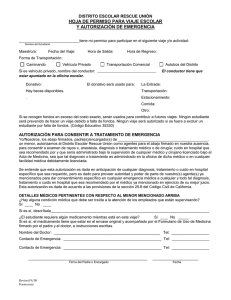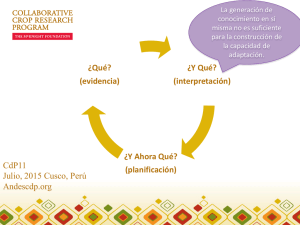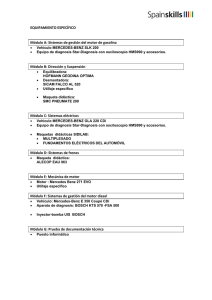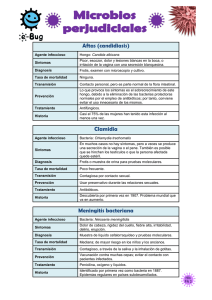rvm38303.pdf
Anuncio
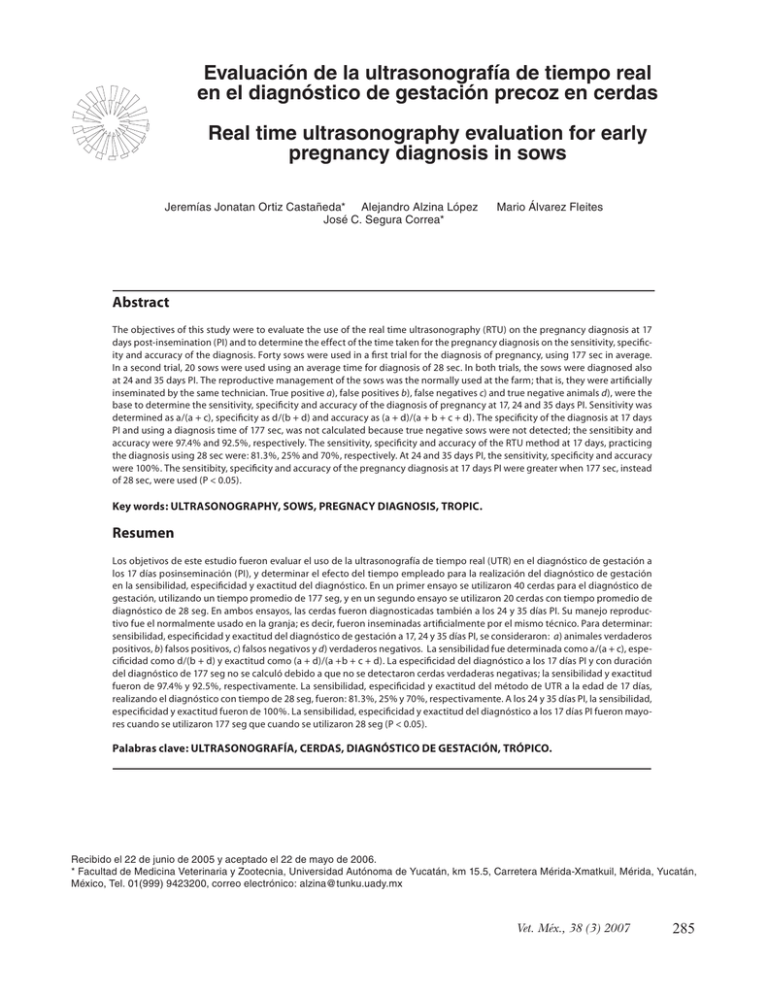
Evaluación de la ultrasonografía de tiempo real en el diagnóstico de gestación precoz en cerdas Real time ultrasonography evaluation for early pregnancy diagnosis in sows Jeremías Jonatan Ortiz Castañeda* Alejandro Alzina López José C. Segura Correa* Mario Álvarez Fleites Abstract The objectives of this study were to evaluate the use of the real time ultrasonography (RTU) on the pregnancy diagnosis at 17 days post-insemination (PI) and to determine the effect of the time taken for the pregnancy diagnosis on the sensitivity, specificity and accuracy of the diagnosis. Forty sows were used in a first trial for the diagnosis of pregnancy, using 177 sec in average. In a second trial, 20 sows were used using an average time for diagnosis of 28 sec. In both trials, the sows were diagnosed also at 24 and 35 days PI. The reproductive management of the sows was the normally used at the farm; that is, they were artificially inseminated by the same technician. True positive a), false positives b), false negatives c) and true negative animals d), were the base to determine the sensitivity, specificity and accuracy of the diagnosis of pregnancy at 17, 24 and 35 days PI. Sensitivity was determined as a/(a + c), specificity as d/(b + d) and accuracy as (a + d)/(a + b + c + d). The specificity of the diagnosis at 17 days PI and using a diagnosis time of 177 sec, was not calculated because true negative sows were not detected; the sensitibity and accuracy were 97.4% and 92.5%, respectively. The sensitivity, specificity and accuracy of the RTU method at 17 days, practicing the diagnosis using 28 sec were: 81.3%, 25% and 70%, respectively. At 24 and 35 days PI, the sensitivity, specificity and accuracy were 100%. The sensitibity, specificity and accuracy of the pregnancy diagnosis at 17 days PI were greater when 177 sec, instead of 28 sec, were used (P < 0.05). Key words: ULTRASONOGRAPHY, SOWS, PREGNACY DIAGNOSIS, TROPIC. Resumen Los objetivos de este estudio fueron evaluar el uso de la ultrasonografía de tiempo real (UTR) en el diagnóstico de gestación a los 17 días posinseminación (PI), y determinar el efecto del tiempo empleado para la realización del diagnóstico de gestación en la sensibilidad, especificidad y exactitud del diagnóstico. En un primer ensayo se utilizaron 40 cerdas para el diagnóstico de gestación, utilizando un tiempo promedio de 177 seg, y en un segundo ensayo se utilizaron 20 cerdas con tiempo promedio de diagnóstico de 28 seg. En ambos ensayos, las cerdas fueron diagnosticadas también a los 24 y 35 días PI. Su manejo reproductivo fue el normalmente usado en la granja; es decir, fueron inseminadas artificialmente por el mismo técnico. Para determinar: sensibilidad, especificidad y exactitud del diagnóstico de gestación a 17, 24 y 35 días PI, se consideraron: a) animales verdaderos positivos, b) falsos positivos, c) falsos negativos y d) verdaderos negativos. La sensibilidad fue determinada como a/(a + c), especificidad como d/(b + d) y exactitud como (a + d)/(a +b + c + d). La especificidad del diagnóstico a los 17 días PI y con duración del diagnóstico de 177 seg no se calculó debido a que no se detectaron cerdas verdaderas negativas; la sensibilidad y exactitud fueron de 97.4% y 92.5%, respectivamente. La sensibilidad, especificidad y exactitud del método de UTR a la edad de 17 días, realizando el diagnóstico con tiempo de 28 seg, fueron: 81.3%, 25% y 70%, respectivamente. A los 24 y 35 días PI, la sensibilidad, especificidad y exactitud fueron de 100%. La sensibilidad, especificidad y exactitud del diagnóstico a los 17 días PI fueron mayores cuando se utilizaron 177 seg que cuando se utilizaron 28 seg (P < 0.05). Palabras clave: ULTRASONOGRAFÍA, CERDAS, DIAGNÓSTICO DE GESTACIÓN, TRÓPICO. Recibido el 22 de junio de 2005 y aceptado el 22 de mayo de 2006. * Facultad de Medicina Veterinaria y Zootecnia, Universidad Autónoma de Yucatán, km 15.5, Carretera Mérida-Xmatkuil, Mérida, Yucatán, México, Tel. 01(999) 9423200, correo electrónico: [email protected] Vet. Méx., 38 (3) 2007 285 Introduction Introducción S a reproducción de la cerda es uno de los aspectos más importantes para los productores por su impacto directo en la rentabilidad. El potencial reproductivo de la cerda se mide como la cantidad de cerdos producidos por año, ello significa que las cerdas con intervalos entre partos más cortos y camadas más numerosas producirán más cerdos y disminuirán los costos de producción. El diagnóstico de gestación en las cerdas es importante debido a la necesidad de identificar fallas reproductivas y, consecuentemente, disminuir los días no productivos y los costos de producción de los lechones. El método ideal para diagnosticar la gestación es el que permita la confirmación de la preñez en el menor tiempo después del servicio o inseminación, que debe tener alta sensibilidad y especificidad.1 Una de las herramientas que ayudan a mejorar la productividad en las granjas de cerdos es la ultrasonografía en tiempo real (UTR), que se utiliza en México para el diagnóstico de preñez a 35 días posinseminación (PI). El problema de este periodo es que cuando no hay buena detección de estros, las hembras no gestantes pierden su primer ciclo estral y hay que esperar el siguiente para volver a inseminarlas, ello ocasiona pérdidas económicas por días no productivos (DNP). El diagnóstico de gestación precoz permite definir el destino de las cerdas vacías, induciéndolas al estro o eliminándolas (para el caso de repetidoras reincidentes); por consiguiente, se disminuyen los DNP y los costos de producción. Otro factor importante es la duración del diagnóstico por cerda, que afecta la sensibilidad y especificidad del diagnóstico.1 Los objetivos de este estudio fueron: evaluar el uso de UTR en el diagnóstico de gestación precoz y determinar el efecto del tiempo empleado para la realización del diagnóstico de gestación sobre la sensibilidad, especificidad y exactitud del diagnóstico. ow reproduction is one of the most important aspects for producers because of its direct impact on profitability. Sow reproductive potential is assessed by the number of pigs produced per year. This means that sows with shorter birth intervals and more numerous litters will produce more pigs and diminish production costs. The relevance of sow pregnancy diagnosis relays on the necessity to identify reproductive failures, in order to decrease nonproductive days and piglet production costs. An ideal diagnosis method should allow pregnancy confirmation in the shortest time after service or insemination; it must have high sensitivity and specificity.1 Real time ultrasonography (RTU) improves swine farm productivity; it is used in Mexico for pregnancy diagnosis on day 35 post-insemination (PI). The problem with this period is that if estrus detection is not good, non pregnant sows loose their first estrus cycle and they have to wait until the next cycle to be inseminated, causing economical losses due to non-productive days (NPD). Early pregnancy diagnosis allows to define the status of the non-pregnant sows, and to decide if estrus induction or elimination (for relapsing repeaters) are performed, in order to reduce NPD and production costs. Duration of diagnosis per sow is another important factor that affects diagnosis sensitivity and specificity.1 The objectives of this study were to evaluate RTU use in early pregnancy diagnosis and to assess the time needed for the pregnancy diagnosis test over sensitivity, specificity and accuracy of the diagnosis. Material and methods This study was done from August to December 2004 in a farrow-to-finish farm, with 3 200 breeding females approximately. The farm is located in southern Yucatan, Mexico, with 26.3º C mean annual temperature, 1 200 mm of mean annual precipitation and relative humidity between 66% and 89%; wind is predominately from north to southeast.2,3 Two assays were done. In the fist one, forty sows with three to seven births were used for pregnancy diagnosis by RTU with a mean scanning time of 177 sec. at day 17 PI. For the second assay, 20 sows with three to seven births were used, with a mean scanning time of 28 sec. Twenty eight seconds is the time needed to perform pregnancy diagnosis under commercial conditions, while 177 sec. is the mean time needed when looking for high efficacy diagnosis. Time elapsed during diagnosis was recorded by a chronometer, starting when probe was placed (transductor) until 286 L Material y métodos El estudio se realizó de agosto a diciembre de 2004 en una granja porcina de ciclo completo, con aproximadamente 3 200 vientres, localizada en la zona sur de Yucatán, México, con temperatura promedio anual de 26.3ºC, precipitación promedio anual de 1 200 mm y humedad relativa promedio entre 66% y 89%, con vientos predominantes de norte a sureste.2,3 El estudio constó de dos ensayos. En el primero, para el diagnóstico de gestación por ultrasonografía de tiempo real (UTR), se utilizaron 40 cerdas de tres a siete partos, con tiempo de diagnóstico promedio de 177 seg, al día 17 posinseminación (PI). En el segundo se utilizaron 20 cerdas de tres a siete partos, con product or vesicle with liquid were located. Sows were diagnosed again on days 24 and 35 PI for both assays. The sows used for this study were randomly picked up from sows inseminated during the same week. Sows were individually identified and located in individual cages; all females received the same kind of food as the rest of the animals in the farm. Reproductive management for the sows was the regular one used in the farm. One specific sow was inseminated by the same technician. RTU equipment* was used for early pregnancy diagnosis. Test result (pregnant or non pregnant) was done based on real time observation of the embryonic vesicles with liquid and presence of fluid at days 17, 24 and 35 PI and embryonic formation in pregnant females. Negative and false positive females were detected using boars on days 17 to 25 PI. Sows in estrus were inseminated, the others were examined by RTU to detect false negative sows. Estrus detections with boars for both groups was done in a specific place, ten minutes a day, with no more than six to eight females and establishing physical contact among animals to improve stimulation; sows in estrus were inseminated. Time elapsed during diagnosis per sow was also recorded. Positive, false positive, false negative and negative females were used to asses: sensitivity, specificity and accuracy of the pregnancy diagnosis at days 17 to 24 PI, taking 35-day-diagnosis as reference. Sensitivity was assessed as a/(a + c), specificity as d/(b + d) and accuracy as (a + d)/(a + b + c + d).4 Effect of diagnosis day or time (28 and 177 sec) on sensitivity, specificity and accuracy of the diagnostic test was evaluated by comparing the ratio for two samples.5 Results Using a scanning time of 117 sec., 39 sows were diagnosed as pregnant and one as non pregnant on day 17 PI. Two of the sows diagnosed as pregnant were false positive (non pregnant), while the non pregnant sow was in deed a false negative. Results on sensitivity, specificity and accuracy according to day of diagnosis are shown in Table 1. Diagnosis sensitivity and accuracy using RTU for 117 sec on day 17 PI were 97.4% and 92.5%, respectively; specificity could not be assessed because true negative sows were not detected. Sensitivity, specificity and accuracy using RTU on day 17 PI for 28 sec were 81.3%, 25% and 70%, respectively. Significant difference was not found for sensitivity between diagnosis times on day 17 PI (P > 0.05); however, a difference was found for accuracy on the same day (P < 0.05). Accuracy was higher when 117 sec were used instead of 28 sec (Table 1). Sensitivity, specificity and accuracy were 100% on days 24 and 35 PI. Comparing accuracy on days 17 vs. 24 yield no significant tiempo de diagnóstico promedio de 28 seg. El tiempo de 28 seg es el que toma realizar el diagnóstico de gestación bajo condiciones comerciales, y el de 177 seg es el tiempo promedio empleado buscando alta eficiencia en el diagnóstico. El tiempo que duró el diagnóstico se registró mediante un cronómetro, empezando a contar desde la colocación de la sonda (transductor) hasta la localización del producto o vesícula con líquido. En ambos ensayos, las cerdas fueron diagnosticadas de nuevo a los 24 y 35 días PI. Las cerdas utilizadas en este estudio se seleccionaron al azar entre las inseminadas en una misma semana e identificadas individualmente; que se alojaron en jaulas individuales y recibieron el mismo tipo de alimento que el resto de los animales de la granja. El manejo reproductivo para las cerdas fue el normalmente usado en la granja. Una determinada cerda fue inseminada por el mismo técnico. Para el diagnóstico de preñez se utilizó un equipo de UTR.* El resultado de preñez (gestante o no gestante) se estableció con base en la observación en tiempo real de las vesículas embrionarias, sacos de líquido y presencia de fluido a los 17, 24 y 35 días PI, y la formación embrionaria en hembras gestantes. Para detectar a las hembras negativas y falsas positivas se utilizaron verracos del día 17 al día 25 PI. Las cerdas que presentaron estro fueron inseminadas, y a las que no, se les inspeccionó con UTR para detectar a las falsas negativas. Para ambos grupos, la detección de estros con verraco se realizó en un lugar específico por diez minutos al día, con no más de seis a ocho hembras y estableciendo contacto físico entre los animales para una mejor estimulación; las hembras que presentaron estro fueron inseminadas. También se registró el tiempo que duró el diagnóstico en cada cerda. Animales positivos, falsos positivos, falsos negativos y negativos, fueron la base para determinar: sensibilidad, especificidad y exactitud del diagnóstico de gestación a 17 y 24 días PI, tomando como referencia el diagnóstico a los 35 días. La sensibilidad fue determinada como a/(a + c), la especificidad como d/(b + d) y la exactitud como (a + d)/(a + b + c + d).4 El efecto del día de diagnóstico o el tiempo de diagnóstico (28 y 177 seg) sobre la sensibilidad, especificidad y exactitud de la prueba diagnóstica se hizo mediante la comparación de las proporciones para dos muestras.5 Resultados A los 17 días PI, utilizando un tiempo de diagnóstico de 177 seg, se diagnosticaron 39 cerdas gestantes y una hembra vacía. De las cerdas diagnosticadas gestantes, *Modelo 50S Tringa Vet de Pie Medical Equipment; de 3.5 y 5.0 Mhz, Holanda. Vet. Méx., 38 (3) 2007 287 difference (P < 0.05) using 117 sec, but a difference was found for 28 sec (P < 0.05). dos resultaron falsas positivas (no gestantes), mientras que la cerda vacía resultó falsa negativa. Los resultados de sensibilidad, especificidad y exactitud, según el día de diagnóstico, se presentan en el Cuadro 1. La especificidad del diagnóstico utilizando UTR por 177 seg el día 17 PI no pudo ser calculada debido a que no se detectaron cerdas verdaderas negativas; mientras que la sensibilidad y exactitud fueron de 97.4% y 92.5%, respectivamente. La sensibilidad, especificidad y exactitud del método de UTR a la edad de 17 días, realizando el diagnóstico con tiempo de 28 seg, fueron: 81.3%, 25% y 70%, respectivamente. No se encontró diferencia significativa entre tiempos (P > 0.05) de diagnóstico a los 17 días PI sobre la sensibilidad, pero sí sobre la exactitud (P < 0.05); cuando se utilizaron 177 seg, la exactitud fue mayor que cuando se utilizaron 28 seg (Cuadro 1). A los 24 y 35 días PI, la sensibilidad, especificidad y exactitud fueron de 100%. La exactitud obtenida a los 17 vs 24 días de diagnóstico no fue significativa (P < 0.05) cuando se utilizaron 177 seg, pero sí cuando se utilizaron 28 seg (P < 0.05). Discussion RTU specificity for pregnancy diagnosis on day 17 PI for 117 sec. could not be calculated in this study. These results agree with those reported by Viana et al.1 on day 18 PI and by Miller et al.6 on days 20 and 22 PI. This result is due to the small size of the sample. However, Mejia et al.7 recorded a 50% specificity at 18-19 days after service. Specificity was 100% on day 24 PI, similar to that obtained by Viana et al.1 and Mejia et al.7 on day 21 PI. Miller et al.6 reported a 45% specificity on day 24 PI. The inability to assess specificity might be attributable to the number of animals used, farm’s fertility and time spent for diagnosis. Other factors may have interfered, such as technician change, expertise of the technician, kind of transductor and frequency used.8 Even though pregnancy diagnostic sensibility with a 177 sec time was not significant, it rose up to 97.4% on day 17 and it reached 100% on day 24 PI. Williams et al.9 mention that RTU can be used for pregnancy diagnosis with high sensitivity and specificity indexes, because it allows to obtain excellent results since day 21 after service. Mejía et al.7 notified 93%-95% sensitivity on days 17-19 PI, and 98-100% on days 20-23 PI; while Miller et al.6 obtained a 100% sensitivity on days 20, 22 and 24 PI. Belstra 8 mentions that RTU accuracy is high, ranging from 93% to 98% and can reach 100% with experienced technicians on day 22 after service. Miller et al.6 obtained accuracies of 50%, 90% and 99% on days 20, 22 and 24 PI, respectively. Knox10 reports that it is possible to get 100% accuracy in pregnancy Discusión La especificidad del uso de UTR para el diagnóstico de gestación a los 17 días, utilizando 177 seg PI, no pudo ser determinada en este estudio; estos resultados coinciden con los notificados por Viana et al.1 a los 18 días PI, y Miller et al.6 a los 20 y 22 días PI. Este resultado se debió a que el tamaño de la muestra fue relativamente pequeño. Sin embargo, Mejía et al.7 registran especificidades de 50% a los 18-19 días posteriores al servicio. Al día 24 PI, la especificidad fue de 100%, similar a la obtenida por Viana et al.1 y Mejía et al.7 a los 21 días PI. Miller et al.6 notificaron una especificidad de 45% Cuadro 1 SENSIBILIDAD, ESPECIFICIDAD Y EXACTITUD DEL DIAGNÓSTICO DE PREÑEZ UTILIZANDO ULTRASONOGRAFÍA DE TIEMPO REAL, SEGÚN EL DÍA POSINSEMINACIÓN Y DURACIÓN DEL DIAGNÓSTICO DE GESTACIÓN EN CERDAS SENSITIVITY, SPECIFICITY AND ACCURACY FOR PREGNANCY DIAGNOSIS BY REAL TIME ULTRASONOGRAPHY, ACCORDING TO POST-INSEMINATION DAY AND SCANNING DURATION IN SOWS Diagnosis day Sensitivity (%) 177 sec a,b 17 97.4(37/38) 24 Specificity (%) 28 sec a 81.2(13/16) --------- 100.0(38/38)a 100.0(16/16)a 100.0(2/2)a NS NS 100.0(4/4)a 28 sec 25.0(1/4) NS Percentages between columns with different letters are statistically significant (P < 0.05). NS = Percentages between rows are not different (P < 0.05); * Percentages between rows are not different (P < 0.05). 288 177 sec a Accuracy (%) 177 sec 92.5(37/40) 28 sec b 70.0(14/20)a 100.0(40/40)a 100.0(20/20)a NS * diagnosis using the transrectal method with a 5.0 Mhz frequency since days 16-17 PI. Differences among studies can be attributable to several factors. The influence of technician, transductor frequency and type of transductor (3.5 or 5.0 Mhz; lineal o sectorial) on sensitivity, specificity and accuracy using RTU on days 18 to 21 is notified by Armstrong et al.11 Results obtained on day 17 PI are acceptable for commercial conditions, when enough time for scanning is given. The way of making diagnosis (transrectal or transabdominal) influence results as well. Knox10 obtained a 100% accuracy making transrectal diagnosis with a 5.0 Mhz frequency. This concurs with the early diagnosis done in this study on day 17 with a 5.0 Mhz frequency, but through transabdominal via. Working conditions, such as animal filth, schedule and low-light places and environmental conditions have an impact on results as well. The best frequency for precocious ages (days 17 to 21 after service) is 5.0 Mhz, while, as pregnancy advances, the 3.5 Mhz probe is sufficient to get excellent results. Similar results were found in this study since for diagnosis on day 17 a 5.0 Mhz frequency was used, while on days 24 and 35 the frequency used was 3.5 Mhz. Time spent by the technician for pregnancy diagnosis affects the assessment of ssensitivity, specificity and accuracy. In this study, sensitivity and accuracy on day 17 PI improved when a scanning time of 177 sec was used, when comparing to the 28 sec time; however, significant difference was only found for accuracy (P < 0.05). Miller et al.6 point out that 120 seconds are needed on day 22, and even longer periods for diagnosis on day 21, because of the vesicle size in the uterus. The earlier the pregnancy age, the longer the time needed for diagnosis, since more mistakes can be made if time and experience are not enough. This might be caused by the fact that pregnancy traces are more difficult to find in the early stages. When embryo is older, finding it is easier because calcified structures start to form. Sow housing conditions can also affect and increase scanning time, because if the sow is filthy it can impede searching for the product. Abnormalities in the diagnostic area also affect diagnosis, as well as environmental conditions, since scanning is more reliable when done in places with low light. Viana et al.1 found that scanning time with RTU is inversely proportional to embryo age, that is, the younger the embryo, the longer the diagnosis time (20 to 60 sec). RTU is an effective tool for pregnancy diagnosis on day 17 of gestation. Sensitivity, specificity and accuracy increase when more time is spent for scanning on day 17 PI. a los 24 días PI. El hecho de no haber podido calcular la especificidad pudo deberse al número de animales utilizados, la fertilidad en la granja y el tiempo utilizado para el diagnóstico. También pueden intervenir factores como el cambio de técnico, la experiencia de éste, el tipo de transductor y la frecuencia utilizada.8 La sensibilidad del diagnóstico de gestación con tiempo de 177 seg, aunque no fue significativa, aumentó de 97.4% a los 17 días, 100% a los 24 días de diagnóstico PI. Williams et al.9 mencionan que el UTR es un instrumento para el diagnóstico de gestación con alto índice de sensibilidad y especificidad, pues permite obtener excelentes resultados a partir de los 21 días posteriores al servicio. Mejía et al.7 notificaron sensibilidades de 93%-95% a los 17-19 días PI, y de 98%-100% a los 20-23 días; mientras que Miller et al.6 obtuvieron porcentajes de 100 puntos los días 20, 22 y 24 PI. Belstra 8 menciona que el UTR tiene alta exactitud que varía de 93% a 98% y puede llegar a 100% con técnicos con experiencia, al día 22 posterior al servicio. Los días 20, 22 y 24 PI, Miller et al.6 obtuvieron exactitudes de 50%, 90% y 99%. Knox10 menciona que es posible tener 100% de exactitud en el diagnóstico de preñez utilizando el método transrectal con frecuencia de 5.0 Mhz a partir de los días 16-17 PI. Las diferencias entre los estudios pueden deberse a diversos factores. Armstrong et al.11 notifican la influencia del técnico, frecuencia del transductor y tipo de transductor (3.5 o 5.0 Mhz; lineal o sectorial) sobre la sensibilidad, especificidad y exactitud, utilizando UTR de los 18 a 21 días. Los resultados obtenidos a los 17 días PI muestran resultados aceptables para condiciones comerciales, cuando se proporciona el tiempo suficiente. La forma de realizar el diagnóstico (transrectal o transabdominal) también influye en el resultado. Knox10 obtuvo 100% de exactitud en el diagnóstico realizado por vía transrectal y con frecuencia de 5.0 Mhz. Este resultado concuerda con el diagnóstico precoz realizado en este estudio al día 17, con frecuencia de 5.0 Mhz, aunque por vía transabdominal. Asimismo, las condiciones en las que se trabaje, como la suciedad del animal, horarios y lugares con poca luz y condiciones ambientales desfavorables, inciden en la obtención de buenos resultados. A edades precoces (17 a 21 días posteriores al servicio), la mejor frecuencia para realizar el diagnóstico es 5.0 Mhz, mientras que conforme transcurre el tiempo de gestación, la sonda con frecuencia de 3.5 Mhz es suficiente para obtener excelentes resultados. Similares conclusiones se obtuvieron en este estudio, ya que para el diagnóstico a 17 días se utilizó la frecuencia de 5.0 Mhz, y los días 24 y 35 se utilizó la frecuencia de 3.5 Mhz. Un factor que afecta las medidas de sensibilidad, Vet. Méx., 38 (3) 2007 289 Referencias 1. Viana CHC, Gama RD, Vianna WL, Alvarenga MVF, Barnabe RC. Evaluation of ultrasonography on early gestation diagnosis in sows. [Serial online 2000 July 26]; cited 2005 April 6 [4 screen] Available from: URL: http://www.esaote-piemedical.com/application/application.html 2. Instituto Nacional de Estadística, Geografía e Informática. Anuario estadístico del estado de Yucatán. Aguascalientes, Aguascalientes: INEGI, 1998. 3. García E. Modificaciones al sistema de clasificación climática de Köeppen. México DF: Instituto de Geografía, Universidad Nacional Autónoma de México, 1988. 4. Thrusfield M. Veterinary Epidemiology. 2nd ed. London, UK: Blackwell Science Ldt,1995. 5. EpiInfo. A word processing, database, statistics program for public health for epidemiology program office. Center for disease control and prevention. Version 6.04. For Windows. Atlanta, Georgia, USA. 1996. 6. Miller GM, Breen SM, Roth SL, Willenburg MS, Zas SR, Knox RV. Characterization of image and labor requirements for positive pregnancy diagnosis in swine using two methods of real – time ultrasound. J Swine Health Prod 2003;11:233–239. 7. Mejia-Silva W, Cruz-Arambulo R, Calatayud-Marques D, León G, Quintero-Moreno M. Uso de ultrasonografía modo B en tiempo real para el diagnóstico precoz de gestación en la cerda. Revista Científica de la Facultad de Ciencias Veterinarias-Zulia 2001; 11:418–422. 8. Belstran B. Reproductive uses of ultrasonography in swine breeding herds: Present and future applications. (Serial online 2000 Nov 3). [Cited 2004 Oct 29]; Available from: URL: http://mark.asci.ncsu.edu/HealthyHogs/book/2000/conten00.htm. 9. Williams S, Piñeyro P, de la Sota RL. Ultrasonografía reproductiva en producción porcina. Instituto de teriogenología. Analecta veterinaria (VE). 2001; 21:50-56. 10. Knox RV. Visualizing the reproductive tract of the female pig using real-time ultrasonography. J Swine Health Prod 1999; 7: 207-215. 290 especificidad y exactitud es el tiempo empleado por el técnico para el diagnóstico de gestación. En este estudio, la sensibilidad y exactitud a los 17 días PI mejoraron cuando se utilizó un tiempo de diagnóstico de 177 seg, en comparación con el de 28 segundos, aunque sólo en la exactitud se encontró diferencia significativa (P < 0.05). Miller et al.6 indican que al día 22 se necesitan 120 segundos, y tiempo mayor para el diagnóstico a 21 días, debido al tamaño de las vesículas en el útero. A menor edad de gestación, se necesita mayor tiempo para el diagnóstico, ya que si no se dedica el tiempo necesario y no se cuenta con experiencia, puede haber más errores. Esto puede deberse a que es más difícil la localización de indicios de gestación a menor edad. El diagnóstico a mayor edad es más fácil, ya que el embrión se va formando y comienza la apreciación de estructuras calcificadas. Otros factores que pueden afectar y aumentar el tiempo en el diagnóstico de gestación son las condiciones en que se encuentre la cerda, ya que si se encuentra muy sucia, puede afectar al momento de la búsqueda del producto. También las anormalidades en la zona donde se lleva a cabo la realización del diagnóstico, así como las condiciones ambientales donde se esté trabajando son relevantes, ya que la elaboración del diagnóstico se hace de manera más confiable y rápida en lugares donde hay poca luz. Viana et al.1 encontraron que la duración del diagnóstico con UTR aumenta conforme disminuye la edad en que se realiza el diagnóstico (20 a 60 segundos). El UTR es una herramienta eficaz para el diagnóstico de preñez a 17 días de gestación. A mayor tiempo de diagnóstico de gestación por UTR a 17 días PI, se mejora la sensibilidad, especificidad y exactitud en el diagnóstico. 11. Armstrong JD, Fraser R, Robertson M. Use of Realtime ultrasound for pregnancy diagnosis in swine. Amer Assoc of Swine Practitioners 1997; 195-202.
